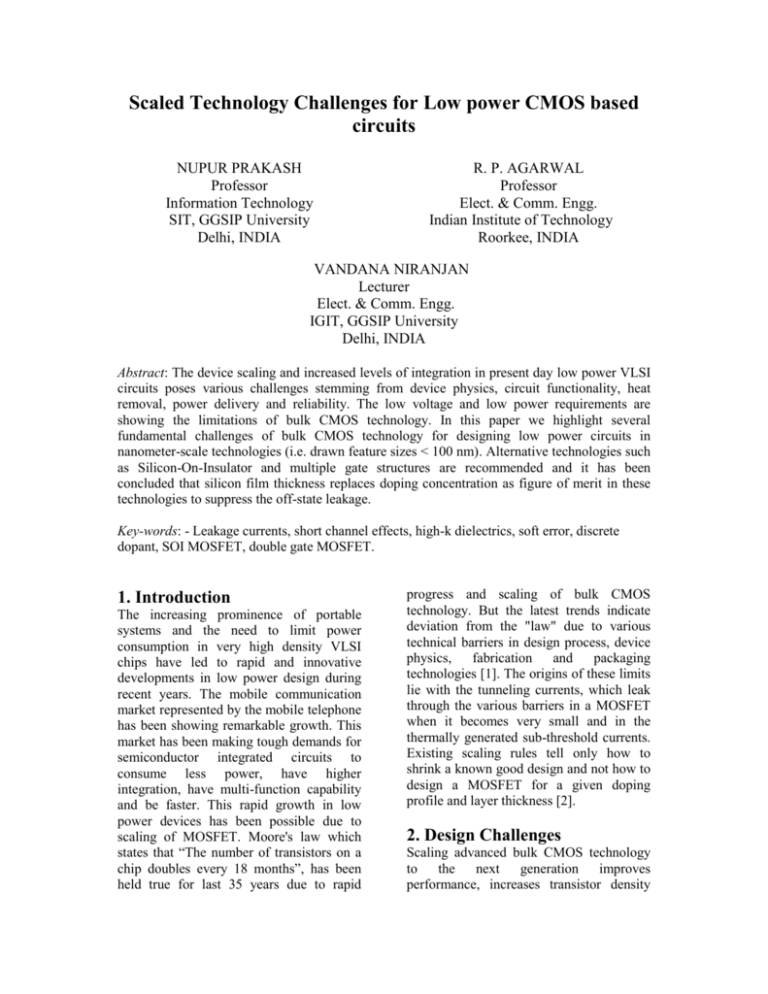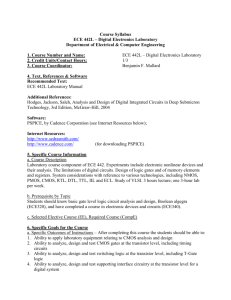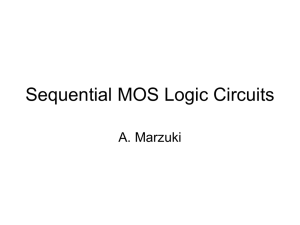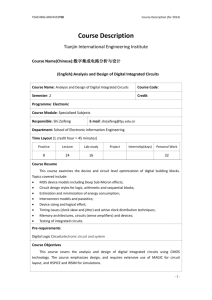487-229
advertisement

Scaled Technology Challenges for Low power CMOS based circuits NUPUR PRAKASH Professor Information Technology SIT, GGSIP University Delhi, INDIA R. P. AGARWAL Professor Elect. & Comm. Engg. Indian Institute of Technology Roorkee, INDIA VANDANA NIRANJAN Lecturer Elect. & Comm. Engg. IGIT, GGSIP University Delhi, INDIA Abstract: The device scaling and increased levels of integration in present day low power VLSI circuits poses various challenges stemming from device physics, circuit functionality, heat removal, power delivery and reliability. The low voltage and low power requirements are showing the limitations of bulk CMOS technology. In this paper we highlight several fundamental challenges of bulk CMOS technology for designing low power circuits in nanometer-scale technologies (i.e. drawn feature sizes < 100 nm). Alternative technologies such as Silicon-On-Insulator and multiple gate structures are recommended and it has been concluded that silicon film thickness replaces doping concentration as figure of merit in these technologies to suppress the off-state leakage. Key-words: - Leakage currents, short channel effects, high-k dielectrics, soft error, discrete dopant, SOI MOSFET, double gate MOSFET. 1. Introduction The increasing prominence of portable systems and the need to limit power consumption in very high density VLSI chips have led to rapid and innovative developments in low power design during recent years. The mobile communication market represented by the mobile telephone has been showing remarkable growth. This market has been making tough demands for semiconductor integrated circuits to consume less power, have higher integration, have multi-function capability and be faster. This rapid growth in low power devices has been possible due to scaling of MOSFET. Moore's law which states that “The number of transistors on a chip doubles every 18 months”, has been held true for last 35 years due to rapid progress and scaling of bulk CMOS technology. But the latest trends indicate deviation from the "law" due to various technical barriers in design process, device physics, fabrication and packaging technologies [1]. The origins of these limits lie with the tunneling currents, which leak through the various barriers in a MOSFET when it becomes very small and in the thermally generated sub-threshold currents. Existing scaling rules tell only how to shrink a known good design and not how to design a MOSFET for a given doping profile and layer thickness [2]. 2. Design Challenges Scaling advanced bulk CMOS technology to the next generation improves performance, increases transistor density and reduces power consumption. The integrated circuit industry has followed a steady path of shrinking device geometry for more than 30 years. It is widely believed that this process will continue for at least another 10 years. However there are increasingly difficult technology and design problems to be solved if this is to actually occur. These limitations constrain the scaling down of devices and circuits to less than a half micrometer and beyond [3]. Some fundamental limitations are discussed in the following sub headings. 2.1 Device physics Scaled down technology has been the major direction for the miniaturization of MOSFET’s. The microfabrication revolution has progressed to such an extent that 107 – 108 transistors can be integrated on a single chip and further research is going on for even smaller dimensions. The physical dimensions are limited by quantum mechanical tunneling currents that pass through the various barriers in the MOSFET when they are sufficiently thin thus degrading the device’s behaviour. There are number of issues associated with continued scaling that represent challenges for the future, discussed in following subsections. 2.1.1 Standby power leakage Power supply is continuously scaled down as technology advances to reduce power dissipation. Supply voltage scaling is fundamentally limited by the need for sufficient gain to provide logic functionality. To attain adequate speed threshold voltage is also scaled down but the effects of leakage currents becomes more pronounced as we move down the sub micro regime i.e. huge increase in weak inversion (subthreshold) current Ioff and reverse-biased p-n junctions leakage current. Leakage current increases exponentially as threshold voltage scales down [4]. Threshold voltage scaling requires much complicated arrangements because built in junction potential and bulk charges do not scale as desired. Threshold voltage scaling requires a decreased impurity concentration in the channel which degrades subthreshold characteristics thus the biggest limit to threshold voltage scaling is the off current 2.1.2 Gate dielectric thickness By purely geometric arguments the gate insulator in a MOSFET needs to be thin compared to the device channel length. This ensures for the gate to exert dominant control over the channel potential. As the gate oxide thickness becomes of the order of 1.0 – 1.5 nm, gate tunneling current from gate to drain or source increases exponentially with decrease in thickness, which is too large for most low power ICs applications. Direct tunneling currents that flow continuously in thin oxide pose some reliability concerns also. Defects such as traps and interface states gradually build up in the oxide to a point where the oxide suddenly and destructively breaks down. Thus a new higher dielectric constant material system will have to be employed starting with the 100nm generation. 2.1.3Gate electrode The gate electrode material itself presents some significant challenges. Doped polysilicon has been used for more than 25 years as the gate electrode material. Due to scaling, doping level needs to be increased which is limited by dopant solubility limits and by dopant outdiffusion from the polysilicon through the thin gate dielectric and into the silicon.The likely solution is again new materials for gate electrodes. But there are no known materials solutions that are known to work in manufacturing [5]. 2.1.4 Short channel effects Short channel device has channel length comparable to depth of drain and source junctions and depletion width. In shortchannel devices, depletion regions from drain and source extend into channel which results in drain electric field penetrating throughout the channel and influencing the channel potential at the source side of the device. This effect known as Short channel effect causes threshold voltage and I/V curve variations resulting uncertainty in circuit designs [6]. Various short channel effects most prominent in small channel MOSFETs are (1)Mobility degradation-lowers the current capability and transconductance of MOST. Mobility degradation deviates the I/V characteristic from the square-law behavior and produces “high harmonics in the drain current”. (2)Carrier Velocity saturation- The effect of velocity saturation is reflected as (a) Premature drain current saturation (b) Reduction of transconductance (3)Drain-induced barrier lowering - Drain voltage VDS causes change in threshold voltage i.e. as drain voltage VDS increases, threshold voltage decreases. For very large VDS, source and drain depletion regions can meet resulting in punch-through effect. (4)Hot carriers effects-increased electric fields causes increased electron velocity resulting in high-energy electrons which can tunnel into gate oxide. This changes the threshold voltage and lead to long-term reliability problems. Junction depths of source/drain extensions must continue to decrease to minimize short channel effects. 2.1.5 Parasitic resistance issues Ideally the current drive in a MOSFET is limited by the intrinsic channel resistance. Various parasitic resistances include contact resistance, source/drain extension sheet resistance. The doping in these regions must increase in order to keep resistances low. But doping concentrations are limited by dopant solubility. Fabrication of shallow junctions with very steep profiles is one solution but it’s very difficult to keep dopants profiles very shallow and steep because transient enhanced diffusion dominates dopant diffusion hence enhancing dopant diffusivities by orders of magnitude. Thus parasitic resistances need to be decreased in order to keep channel resistance as the dominant resistive component in the device [7]. 2.2 Material limits on devices: The signal processing capabilities of a device can be measured by its frequency response (speed of operation) and dynamic range (bit accuracy). Using an idealized analysis, Johnson predicted 27 years ago that all the devices, even if they are made by modern technology, still remain within the physical limitations of the materials. Thus a semiconductor device has the maximum physical capability caused by its material and thus operating speed and operating voltage must be trade off. 2.3 Power limits on circuits Another important limitation is the maximum temperature at which a semiconductor functions properly. The power dissipated in a circuit increases its temperature because there is thermal resistance between a device and its environment. A simple relationship by the author shows that VLSI performance and cost that is speed and packaging density are limited by (a) The maximum temperature rise between a device and its environment (b) The thermal resistance between them which are closely related to the packaging system and the rates of heat production and dissipation [8]. Thus there must be tradeoff between the speed and integration level in a cooling limited situation and this is limited by the switching energy of the circuits and the packaging conditions. 2.4 Processing limits The overall optical lithography trend is going from 248 over 193 to 157 nm wavelengths. The implementation of resolution enhancement techniques such as phase shifting masks (PSM), off-axis illumination (OAI) and optical proximity correction (OPC) options will extend the lifetime of optical lithography and should lead to 65 nm geometries. The questions around the affordability of the lithography tools and the cost of ownership are key issues from a manufacturing viewpoint [9]. For the different technology nodes the device isolation technique has to be optimized. This is not only posing technological difficulties but has a strong impact on the design aspects. The scaling of physical dimensions is limited by the discreteness of dopants which results in large statistical variations. None of the current manufacturing processes controls the exact atomic position of each dopant atom and this uncertainty by itself can lead to substantial threshold variations in very small MOS structures 2.5 Interconnect limits Scaling has strongly improved the transistor speed power product but has also increased the interconnection impedance by raising both the resistance of the metal lines and their capacitive coupling .Making wires narrower to reduce the space that they occupy on chips increases their resistance and leads to transmission delays limited by RC times[10]. Another wire limit arises from the increase in current density as the cross-sectional area of wires decreases. Current density is limited by electromigration - the movement of atoms by electric currents. Increasing the aspect ratio of wires lowers both current density and resistance but increases wire capacitance and detract from performance beyond a certain point. Fabricating wires in layers, allowing coarser wiring in some to contain long wires helps to control wire delays. However costs in the form of increased processing complexity are associated. The reduction of resistance through the replacement of aluminium with copper is underway. Interconnections need higher conductivity material and reduction of capacitance. 2.5 Reliability issues In order to reduce power consumption, the power supply voltage used will probably continue to decrease and there will probably be stronger demand for devices with highfrequency operating performance. As the power supply voltage is reduced, soft errors are becoming quite problematic and major reliability issue. Soft errors are transient disturbances of the information in an electrical circuit. Two sources of energetic radiation cause soft errors at the surface of the earth: radioactive impurities in the materials of the chip and package and particle showers initiated in the high atmosphere by cosmic radiation. Means for preventing system errors involve error correction and component redundancy. When a soft error occurs it is necessary to detect it and to have enough information to correct it or restart the interrupted process which is still a big challenge [12]. 2.6 Cost issues Reduction of the cost would be the biggest driving force of the downscaling. It is difficult to predict how much investment we can consume on the development of new technology and the production of new devices; but it should be noted that the magnitude of the necessary investment is increasing year by year in accordance with the increase in difficulty in technology. Cost increase for the development and production is certainly a big issue but this as an issue to be solved by economy principle. Thus if cost issue is not solved the introduction of the product into the market could be slowed down until it is solved. 3. Beyond classical CMOS As bulk CMOS technology is being scaled down to submicron regime leakage power is imposing major challenges for achieving the expected device performance. With current device dimensions, leakage power is constituting to almost 30% to 40% of total power consumption in the device. As the scaling of the bulk CMOS is approaching its limits, the technology evolution is decelerating to a slower pace. Under such conditions SO1 stands a better chance of becoming the mainstream technology. SO1 configuration opens up the possibility of novel MOSFET structure such as dual-gate SOI, which can lead to even further reduction of power for given performance by means of new circuit design techniques[11],[12]. 3.1 Silicon-On-Insulator technology Silicon on insulator (SOI) is being considered advantageous for low power applications as compared to bulk silicon as a substrate for CMOS technology. There are three main advantages of SO1 MOSFETs relative to bulk MOSFETs for low power circuit applications: 1) Reduced source- and drain-to-substrate capacitance: Sice there are no standard junction of bulk MOSFETs, as much as tenfold capacitance reduction can be achieved. 2) No body-effect: Body effect decreases current drive in stacked devices with scaled-down power supply voltage. 3) Higher ON/OFF current ratio: Thus they are more suitable for reduced Vdd operation at given performance. It has been observed that compared to bulk Si, SOI CMOS can run at 20 to 50% higher switching speeds with a 2 to 3 times lower power consumption for the same speed . SOI MOSFET devices are more resistant to short channel effects [13]. 3.2 Multiple gate structures The double gate device can avoid the needs for very high body doping and very thin gate dielectrics in classical CMOS. They offer much better control of short channel effects and enhanced current drive capability. If we compare the threshold voltage equations 1, 2 and 3 for bulk, SOI and double gate structures then we can say that silicon film thickness in non classical CMOS replaces doping concentration as figure of merit in order to suppress the offstate leakage. For bulk silicon threshold voltage is proportional depletion region width whereas in nonclassical it is proportional to silicon film thickness. Bulk CMOS Vth VFB 2 F qN A t OX 0 OX wdep ....(1) where wdep 4 0 Si F q NA SOI CMOS Vth VFB 2 F qN A tOX 0 OX t Si ....(2) Dual Gate CMOS Vth VFB 2 F qN A tOX 0 OX t Si ....(3) 2 4. Conclusions The low voltage and low power requirements for mobile/battery conserving applications are showing the limitations of Bulk CMOS and opening a new opportunity for SOI. In today's environment of rapid scaling of bulk technology subthreshold and gate leakage currents are rising exponentially. Various short channel effects must be controlled. Gate oxide characterization and reliability analysis needs further investigations. Extensive work on physics, characterization and technology aspects of submicron CMOS is required. Advanced MOS Modeling at Device level needs further research to include short channel effects, sub-threshold operation and leakage currents. As CMOS scaling in conventional bulk Si is approaching its limits for technical or economic reasons for low power operation, SOI have a better chance of becoming the mainstream technology for low power design. New device structures such as double gate CMOS may help to circumvent the difficulties of very thin gate dielectric and very heavy substrate doping. With device and process optimization and an accurate SPICE model for circuit simulation, SOI technology holds the promise to be the “future” technology/device choices for low power CMOS based designs. References: [1] Peter M. Zeitzoff and James E. Chung, “Weighing in on Logic Scaling Trends”, IEEE Circuits and devices magazine, March 2002, pp. 18-27. [2] David J.Frank, Robert H. Dennard, Edward Nowak, Paul M. Solomon, Yuan Taur, Hon-Sum P.Wong, “Device Scaling Limits of Silicon MOSFETs and Their Application Dependencies”, Proceedings of the IEEE, vol.89, no.3, March 2001, pp.259-287. [3] Minoru Nagata, “Limitations, Innovations, and Challenges of Circuits and Devices into a Half Micrometer and beyond”, IEEE Journal of Solid-State Circuits, vol.27, no.4, April 1992, pp. 465472. [4] Hiroshi Iwai, “CMOS Technology – Year 2010 and Beyond”, IEEE Journal of Solid-State Circuits, vol.34, no.3, March 1999, pp.357-366. [5] James D.Plummer and Peter B. Griffin, “Material and Process limits in silicon VLSI Technology”, Proceedings of IEEE, vol.89, no.3, March 2001, pp.240-257. [6] Cor Claeys, “Technological challenges of advanced CMOS processing and their impact on design aspects”, Proceedings of the seventh international conference on VLSI Design, India, January 2004, pp.275282. [7] Nitin Borkar, Siva G. Narendra, Vasantha Erraguntla and James Tschanz, “Design challenges in sub-100 nm high performance microprocessors”, Proceedings of the seventh international conference on VLSI Design, India, January 2004, pp.15-17. [8] James D.Olummer and Peter B. Griffin, “Materials and Process Limits in Silicon VLSI Technology”, Proceedings of the IEEE, vol.89, no.3, March 2001, pp.240257. [9] Bijan Davari, Robert H.Dennard and Ghavam G.Shahidi, “CMOS scaling for high performance and low power-the next ten years”, Proceedings of the IEEE, vol.83, no.4, April 1995, pp.595-606. [10] Vivek De and Shekhar Borkar, “Low Power and High Performance Design Challenges in Future Technologies”, Proceedings of Great Lakes Symposium on VLSI, March 2000, pp. 1-6. [11] James A.Hutchby, George I. Bourianoff, Victor V. Zhirnov and Joe E. Brewer, “Extending the road beyond CMOS”, IEEE Circuits and devices magazine, March 2002, pp.28-41. [12] J M.Alam, B.Weir and P.Silverman, “A future of function or failure”, IEEE Circuits and devices magazine, March 2002, pp. 42-48. [13] Robert W.Keyes, “Fundamental Limits of Silicon Technology”, Proceedings of the IEEE, vol.89, no.3, March 2001, pp.227238.







